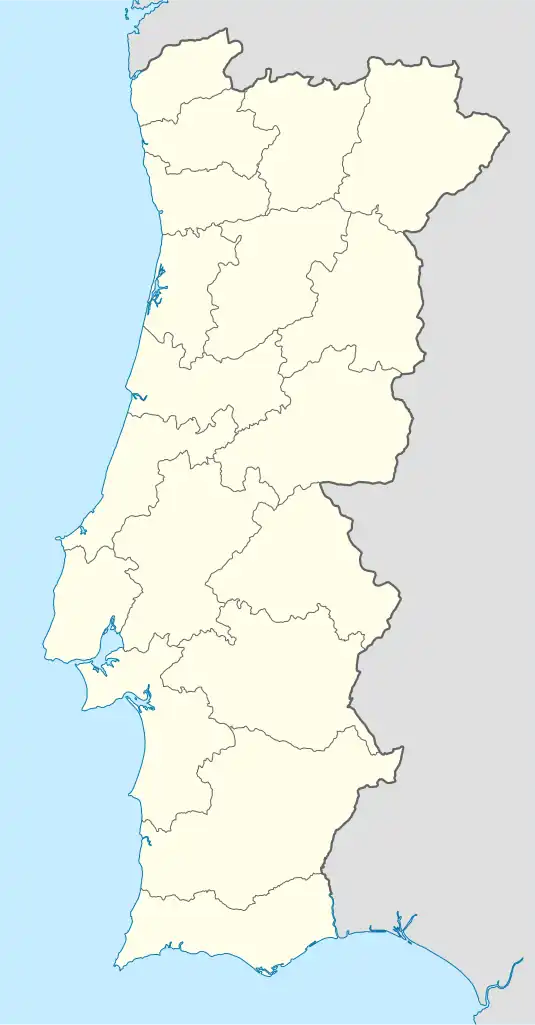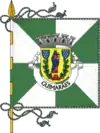 Casa do Arco (House of the Arch), located in the entrance to the São Tiago Square, in 2006 | |
 Location of the street in Portugal | |
| Native name | Rua de Santa Maria (Portuguese) |
|---|---|
| Former name(s) | Rua da Infesta (upper section) |
| Part of | Historic Centre of Guimarães |
| Type | Medieval street |
| Location | Oliveira, São Paio e São Sebastião, Guimarães, Portugal |
| Coordinates | 41°26′39″N 8°17′34″W / 41.444069°N 8.292782°W |
| Construction | |
| Completion | Before the 12th century |
| Other | |
| Status | Preserved |
| Website | www.cm-guimaraes.pt/rua-de-santa-maria |
The Santa Maria Street (Portuguese: Rua de Santa Maria) is a street of medieval origin in the historic centre of Guimarães, being for many centuries the most important street in Guimarães and home to some of its elite.
The street currently connects the Oliveira and the São Paio Square to the Carmo Square. It is already referred to by the name “Rua de Santa Maria” in documents that date to the 12th century, although its upper section was given the old name of Rua da Infesta (Infesta Street).[1]
Along its route there are various notable architectural and cultural testimonies of the past:
- Convent of Santa Clara, a 16th century boroque style convent now used as the câmara municipal of Guimarães.[2][3][4]
- Raul Brandão Library, built in 1834, is dedicated to the renowned figure Raul Brandão and currently serves as the municipal library of Guimarães.[5]
- Casa do Arco, it was built in the end of the 15th century, Manuel I once slept here after coming from a trip to Santiago de Compostela. Other historical figures like king Miguel I the painter Auguste Roquemont also spent some nights here with the last one living here in the 1830s.[6]
- House of the Peixotos, built in the 1700s, it was a noble family’s house.[7]
- House of the Valadares de Carvalho, one of the oldest buildings that are still standing on that street, it was built in the 15th century, it was a noble family’s house.[8]
- House of Senhora Aninhas, the house where the “mother and protector of the students of Guimarães” lived,[9][10] and one of the 5 locations where the Pregão is declaimed.[11]
- The house where Mário de Vasconcelos Cardoso was born.[12][13]
References
- ↑ "Rua de Santa Maria". www.cm-guimaraes.pt (in European Portuguese). Retrieved 2023-12-11.
- ↑ "Monumentos". www.monumentos.gov.pt. Retrieved 2023-12-11.
- ↑ https://em.guimaraes.pt/diretorio/geo_artigo/convento-de-santa-clara
- ↑ "Convento de Santa Clara de Guimarães - Arquivo Nacional da Torre do Tombo - DigitArq". digitarq.arquivos.pt. Retrieved 2023-12-12.
- ↑ "Monumentos". www.monumentos.gov.pt. Retrieved 2023-12-11.
- ↑ "Monumentos". www.monumentos.gov.pt. Retrieved 2023-12-11.
- ↑ "Monumentos". www.monumentos.gov.pt. Retrieved 2023-12-11.
- ↑ "Monumentos". www.monumentos.gov.pt. Retrieved 2023-12-11.
- ↑ "AAELG - Velhos Nicolinos -". www.nicolinos.pt. Retrieved 2023-12-20.
- ↑ "AAELG - Velhos Nicolinos -". www.nicolinos.pt. Retrieved 2023-12-20.
- ↑ Geral. "Nicolinas: «Pregão» realiza-se esta terça-feira em Guimarães". GUIMARAESDIGITAL.COM (in European Portuguese). Retrieved 2023-12-20.
- ↑ https://files.dre.pt/2s/2006/11/216000000/2493524936.pdf
- ↑ https://www.patrimoniocultural.gov.pt/static/data/recursos/bibliotecas_e_arquivos/biografias/biografiadomariocardozo.pdf
Wikimedia Commons has media related to Santa Maria Street.
This article is issued from Wikipedia. The text is licensed under Creative Commons - Attribution - Sharealike. Additional terms may apply for the media files.
